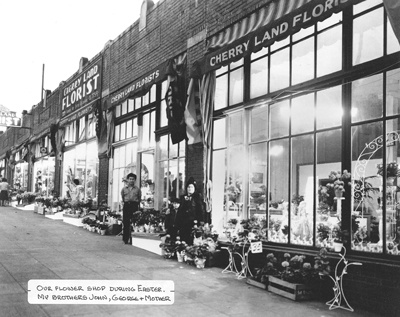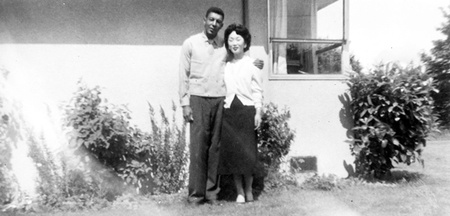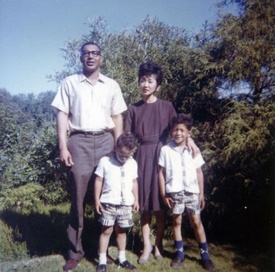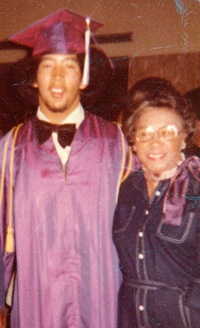Bruce Harrell, former Seattle City Council member for twelve years (2007-2019), has rare life experience as a biracial child of an African American father and Japanese American mother. Growing up in Seattle in the 1960s-70s, his background has shaped his outlook, his family values, and ultimately, his vision for Seattle as he runs for mayor this summer and fall. If elected, he would be Seattle’s second Black and first Asian American mayor.
* * * * *
Please tell us about your family’s history in Seattle — starting with your grandparents and then how your father met your mother.
My Japanese grandmother was Tameno Habu-Kobata. She was born in Osaka, Japan and married Teiji Habu. They came to Seattle in the early 1900s and had six children: Jack, Kimi, John, Yuki, Kako, and Mary. They lived in Seattle’s Central Area and opened a small grocery store.
Many Seattleites remember the old Garland Florist near 10th and South Jackson Street, run by Kako (Habu) Shinbo and her husband “Doc” Shinbo. People may also remember Jack Habu’s successful auto repair shop located off South Jackson Street. Today, it is still run by his sons, Art and Gordon Habu.
Grandpa Habu died at a young age from meningitis. On his death bed, he asked his best friend, John Kobata, to take care of his wife and six children. John did so and my grandmother Tameno eventually married him. From her second marriage came five more children: George, Louise, Frank, George, and my mother Rose, their youngest. Rose’s father was a florist, thus the name “Rose.” There were two “Georges” because the first one died very early.
My mother’s sister, Louise (Kobata) Sakuma, ran Cherryland Florist at 12th and Yesler Way in the Central Area for decades. Today, she resides not far from the area. All of these family members were incarcerated in the Minidoka incarceration camp during WWII, including my mother Rose.

After incarceration, my mother attended Seattle’s Garfield High School and met my father, Clayton Harrell, Sr., there. My father’s family had moved to Seattle from New Orleans, Louisiana. His father, William Harrell, was a carpenter who built his own home in Seattle’s Madison Valley. Two of his three sons graduated from the University of Washington (UW) with graduate degrees in the 1950s. My grandmother, Lillian Harrell, was a Licensed Nurse Practitioner at First Hill’s Cabrini Hospital in the newborn unit.
My parents graduated from Garfield in 1951 and got married in 1953 so, of course at the time, family members on both sides were concerned. Many of mom’s siblings did not openly embrace my father as an African American, but over the years, he charmed them all.
Legendary music composer Quincy Jones was in their high school class and my father played with him in a band known as Bumpy Blackwell’s Band. They were legendary in Seattle.
Marrying out of their races at the time, my parents faced stares and doubt from every vantage. I recall walking the streets of downtown seeing people stare at my father, my mother, and then my brother and me as though we were from another planet. But my parents never left each other’s sides through five decades of marriage and truly lived the motto “till death do us part.”
Please tell us more about your Nikkei mother, her growing up, her career as an adult.
My mother, Rose Tamaye Kobata, was born on July 17, 1933 in Seattle and as noted, was the youngest of 11 children. She attended the Central Area’s Bailey Gatzert Elementary School, Washington Middle School, and Garfield, and took some classes at the UW in accounting.
She was both mother and career woman. She worked as a secretary at the East Madison YMCA, at “The Facts“ (local African American newspaper, still in operation today), and as a business manager for the Seattle Model Cities program under Walter Hundley. The majority of her career was as finance manager at the Seattle Public Library.
My mother passed away on October 14, 2014, from heart failure at age 81. My wife, Joanne, and I were with her the day before, enjoying a football game, and her sense of humor, feistiness and joy were with her to her very last breath.
What was it like growing up in a Black/Japanese biracial family in the 1960s and 1970s? What instances of both acceptance and/or discrimination do you recall?
Growing up, I always questioned where I fit in relation to racial groups. I had to check two boxes in forms asking for “race” and when asked to participate in discussions regarding “race” in those days, I was hesitant to speak out knowing that others had different experiences than I had.
It was not until I was a student at UW where I started to meet more and more mixed-race people and I was quite excited about befriending them. But what I remember most, aside from the challenges, was how I had friends from every race and background who loved and respected me. I learned at an early age that the fuel to keep in my tank was the love that always surrounded me. When someone says something hurtful, I rely on those positive influencers in my life that keep me energized. I feed off of that even today, regardless of what race they are.
My mother, who was indeed a “superwoman,” provided me and my older brother, Clayton, Jr., with the love, confidence, and armor to deal with the ignorance and negative judgments that we would face being biracial. As a kid, I was called unimaginable names, often resulting in fights.
That love, coming from a Japanese mother and a Black father, fuels me even after they have both physically departed from this earth. And today, even with all the anti-Asian hate and violence against Black, Indigenous, and People of Color (BIPOC), I still resort to love as my shield and armor.
Proudly, I have a beautiful wife, Joanne, three children and two grandchildren, and many wonderful nieces and nephews — all boasting diverse ethnic and cultural backgrounds.
Were your parents your greatest role models as you navigated growing up in Central Seattle and among other accomplishments, as you became a Garfield class valedictorian and later, a UW football player?
I loved my father as much as a son could love a father and he was a good father to me. He died of cancer in 2003. He was a great man.
But I attribute my confidence, athletic ability, mental toughness, and spiritual foundation to my mother.
My mother loved to read and she made me read to her out loud every night as a child while she would wash the dishes by hand. I would finish a book only to start another book, day after day, year after year. She impressed upon me the need to learn and to be curious about things.
She taught Sunday school in church and helped with Women’s Day. When I was a child, she was active in the PTSA (Parent Teacher Student Association). She never missed a game in any sport that I was involved in. I would tell her that I wanted to start early morning workouts and she would wake me up to do it. She would make sure I would sleep, study, and plan. She set high expectations for me and I always watched how hard she worked. She would rise early, fix breakfast, work all day, fix dinner, and clean the kitchen by herself. I would help her clean the kitchen as I got older because the woman had more stamina than anyone I knew.
One day in high school, I was in a wrestling tournament at 190 pounds weight. I won the first match and she waited for me in the car for four hours to give me a ride home.
When I got in the car, she said, “What took you so long?”
I said, “What do you mean, I ran out here right after the match.”
She said, “That was like four hours ago.”
I said, “Mom, I had two more matches. It’s a tournament. I won them. Didn’t you see?”
She said, “No, I was reading a book.”
But she never complained. Yet, here I was I complaining that she didn’t see me and she was the only family member there. So, she took me to get burgers and we laughed about it. She was the dynamo in my life.
*This article was originally publshed in the North American Post on July 9, 2021. All photos are courtesy of Harrell family.
© 2021 Elaine Ikoma Ko / The North American Post










